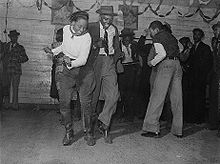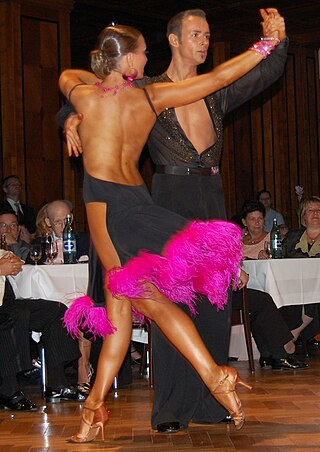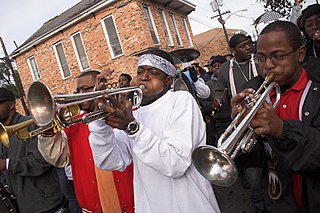This article may require cleanup to meet Wikipedia's quality standards. The specific problem is: some placeshave nonencyclopedic ctyle.(December 2023) |

American social dancing has been changing through the decades.
This article may require cleanup to meet Wikipedia's quality standards. The specific problem is: some placeshave nonencyclopedic ctyle.(December 2023) |

American social dancing has been changing through the decades.
The 20th century brought about a change in social dances. The "old fashioned and out of step" dances such as "the waltz and polka" needed to make way "for something different and new". [1] In the past, only upper class dances had been recorded because lower class dances were "not deemed worthy of record". [1] However, in the 20th century, "the Industrial Age was upon us, a new middle class was emerging and great social ... innovations were on the horizon". [1] The upper class even became more accepting of dance music that began in lower classes. An example of this is ragtime dance and music. Ragtime had a "lively, infectious new sound". [1] Some other forms of dancing that made a huge impact were jazz and swing dance. These dances are both energetic and had their own personality and culture. Jazz was danced to jazz music and swing was danced to big band music.
Social dance plays a significant role in our society because it brings people together in a way that nothing else does. Social dancing is just that - social. Its purpose is not for competition or for performance. It is fun and is part of culture and society. It serves "as the social center" and "the artistic release" in society. [1] It is assumed "that dance will survive as long as it satisfies a contemporary social need and" beauty. [1]
There are many dancing styles of the past that are hardly used anymore. Styles from the 18th and 19th century such as the waltz and polka have practically disappeared from dance culture. Although many dances are not used anymore, there are some people that continue to enjoy dancing dated dances such as swing. Styles from the 20th century such as swing dancing are still done, but are not necessarily well known or popular.
Ragtime and jazz dance were both iconic dances of the 20th century. Both of them contained syncopated rhythms and dance steps that were very different from the polite and proper dance steps from centuries before. The new technology that came with the century made way for new ways of thinking, which in turn brought new music and exciting new dances.
Ragtime music was at the height of its popularity from 1895 to 1918. Soon there were also dance moves created to go along with the music. Ragtime "appeared, fresh and new, [and] its syncopate sounds quickly became popular". [1] "Scott Joplin [had his first album,] Maple Leaf Rag was published in 1898 ... [and] for two decades, Ragtime was almost the only new music composed in America". [1] When ragtime music was created, the upper class originally was against it. They felt that it was "more suitable for the lower classes, but its lively, infectious new sound eventually won out and Ragtime music was in". [1] Ragtime "produced a sound very different from the 19th Century ballroom music" and therefore became a popular social dance of the upper, middle, and lower classes. [1] After 1917, ragtime became less popular as Jazz caught the public's attention.
Jazz dance was iconic to the beginning of the 20th century and beyond. Its evolution began on plantations by "Africans held captive in the United States". [2] Jazz dance was "practiced among blacks in social settings like house parties, dives, honky tonks, and jook joints". [2] It was also included in night clubs such as "the Cotton Club ... as well as in staged musicals… [such as] Shuffle Along... and Runnin’ Wild". [2] Jazz attire included articles such as "hats, feather boas, pleated trousers, skirts, shorts, and dresses". [2] Jazz dancers hold their bodies a certain way when they are dancing. "The center of gravity is lowered ... the torso is inclined forward ... the entire body is engaged, resulting in movement that is initiated almost entirely through syncopated foot actions". [2] There are many instances in which vocalization are included in the dance, such as when dancers call out a dance move. [2] Dancing to jazz requires a "’jazz state of mind’ ... [which is] a way of moving that is simultaneously energized and laid back". [2]
Swing dance had its connections to ragtime and jazz dance, which came before it, as well as rock and roll, which came after it. People studying these dance forms have noticed the similarities in certain swing moves that resemble dance moves from rock and roll.
Swing dance became popular in the late 1920s and maintained its popularity into the 1940s and 1950s. [3] It faded away "with the birth of rock ‘n’ roll, [then] reemerged in the 1990s". [3] This was a form of self-expression. A swing ‘scene’ is a location in which social interactions, music and dancing happens. [3] Big band music went hand in hand with swing dancing. [4] The swing scene started out edgy and then eventually it merged with popular culture. [3] This resulted in more social dancing and less striving for a unique edge as had happened before. [3] Swing dance was unique from other dance forms in that it provided human touch. This aspect of the dance separated it from other dance forms in which touch is not involved. [3] Swing dancers purposefully tried to "revitalize partner dancing and [reclaim] a vital form of social interaction based on closeness". [3]
Rock and roll eventually "replaced jazz as the teenager’s dance music of choice". [2] Rock and roll became more popular in the 1950s and 1960s. [2] There were many similarities between this and jazz dance regarding various movements for dances. [2] For example, there were "similarities in the foot actions of Sugar Foot from the 1920s and the Mashed Potato popular in the 1960s". [2]
Jazz is a music genre that originated in the African-American communities of New Orleans, Louisiana, in the late 19th and early 20th centuries, with its roots in blues, ragtime, European harmony and African rhythmic rituals. Since the 1920s Jazz Age, it has been recognized as a major form of musical expression in traditional and popular music. Jazz is characterized by swing and blue notes, complex chords, call and response vocals, polyrhythms and improvisation.

Ragtime, also spelled rag-time or rag time, is a musical style that had its peak from the 1890s to 1910s. Its cardinal trait is its syncopated or "ragged" rhythm. Ragtime was popularized during the early 20th century by composers such as Scott Joplin, James Scott and Joseph Lamb. Ragtime pieces are typically composed for and performed on piano, though the genre has been adapted for a variety of instruments and styles.

Swing dance is a group of social dances that developed with the swing style of jazz music in the 1920s–1940s, with the origins of each dance predating the popular "swing era". Hundreds of styles of swing dancing were developed; those that have survived beyond that era include Charleston, Balboa, Lindy Hop, and Collegiate Shag. Today, the best-known of these dances is the Lindy Hop, which originated in Harlem in the early 1930s. While the majority of swing dances began in African-American communities as vernacular African-American dances, some influenced swing-era dances, like Balboa, developed outside of these communities.
Swing music is a style of jazz that developed in the United States during the late 1920s and early 1930s. It became nationally popular from the mid-1930s. The name derived from its emphasis on the off-beat, or nominally weaker beat. Swing bands usually featured soloists who would improvise on the melody over the arrangement. The danceable swing style of big bands and bandleaders such as Benny Goodman was the dominant form of American popular music from 1935 to 1946, known as the swing era, when people were dancing the Lindy Hop. The verb "to swing" is also used as a term of praise for playing that has a strong groove or drive. Musicians of the swing era include Duke Ellington, Benny Goodman, Count Basie, Cab Calloway, Benny Carter, Jimmy Dorsey, Tommy Dorsey, Woody Herman, Earl Hines, Bunny Berigan, Harry James, Lionel Hampton, Glenn Miller, Artie Shaw, Jimmie Lunceford, and Django Reinhardt.

The United States' multi-ethnic population is reflected through a diverse array of styles of music. It is a mixture of music influenced by the music of Europe, Indigenous peoples, West Africa, Latin America, Middle East, North Africa, amongst many other places. The country's most internationally renowned genres are traditional pop, jazz, blues, country, bluegrass, rock, rock and roll, R&B, pop, hip-hop/rap, soul, funk, religious, disco, house, techno, ragtime, doo-wop, folk, americana, boogaloo, tejano, surf, and salsa, amongst many others. American music is heard around the world. Since the beginning of the 20th century, some forms of American popular music have gained a near global audience.
Jazz standards are musical compositions that are an important part of the musical repertoire of jazz musicians, in that they are widely known, performed, and recorded by jazz musicians, and widely known by listeners. There is no definitive list of jazz standards, and the list of songs deemed to be standards changes over time. Songs included in major fake book publications and jazz reference works offer a rough guide to which songs are considered standards.

Partner dances are dances whose basic choreography involves coordinated dancing of two partners, as opposed to individuals dancing alone or individually in a non-coordinated manner, and as opposed to groups of people dancing simultaneously in a coordinated manner.

Social dances are dances that have social functions and context. Social dances are intended for participation rather than performance. They are often danced merely to socialise and for entertainment, though they may have ceremonial, competitive and erotic functions.
The United States of America is the home of the hip hop dance, swing, tap dance and its derivative Rock and Roll, and modern square dance and one of the major centers for modern dance. There is a variety of social dance and performance or concert dance forms with also a range of traditions of Native American dances.

Music in the United States underwent many shifts and developments from 1900 to 1940. The country survived both World War I and the Great Depression before entering World War II in December 1941. Americans endured great loss and hardship but found hope and encouragement in music. The genres and styles present during this period were Native American music, blues and gospel, jazz, swing, Cajun and Creole music, and country. The United States also took inspiration from other cultures and parts of the world for her own music. The music of each region differed as much as the people did. The time also produced many notable singers and musicians, including jazz figure Louis Armstrong, blues and jazz singer Mamie Smith, and country singer Jimmie Rodgers.

Music history of the United States includes many styles of folk, popular and classical music. Some of the best-known genres of American music are rhythm and blues, jazz, rock and roll, rock, soul, hip hop, pop, and country. The history began with the Native Americans, the first people to populate North America.
Contradanza is the Spanish and Spanish-American version of the contradanse, which was an internationally popular style of music and dance in the 18th century, derived from the English country dance and adopted at the court of France. Contradanza was brought to America and there took on folkloric forms that still exist in Bolivia, Mexico, Venezuela, Colombia, Peru, Panama and Ecuador.

American popular music is popular music produced in the United States and is a part of American pop culture. Distinctive styles of American popular music emerged early in the 19th century, and in the 20th century the American music industry developed a series of new forms of music, using elements of blues and other genres. These popular styles included country, R&B, jazz and rock. The 1960s and 1970s saw a number of important changes in American popular music, including the development of a number of new styles, such as heavy metal, punk, soul, and hip hop.

Novelty piano is a genre of piano and novelty music that was popular during the 1920s. A successor to ragtime and an outgrowth of the piano roll music of the 1910s, it can be considered a pianistic cousin of jazz, which appeared around the same time. "Nola," a 1915 composition by New York pianist Felix Arndt, is generally considered the first novelty piano hit. Many early novelty composers were piano roll artists from the Chicago area, where two of the largest piano roll companies, QRS and Imperial, were based. While often only lightly syncopated or lacking syncopation entirely, novelty piano influenced the evolution of jazz. It is distinct from stride piano, which was developed in New York at about the same time.

Dance music is music composed specifically to facilitate or accompany dancing. It can be either a whole piece or part of a larger musical arrangement. In terms of performance, the major categories are live dance music and recorded dance music. While there exist attestations of the combination of dance and music in ancient history, the earliest Western dance music that we can still reproduce with a degree of certainty are old-fashioned dances. In the Baroque period, the major dance styles were noble court dances. In the classical music era, the minuet was frequently used as a third movement, although in this context it would not accompany any dancing. The waltz also arose later in the classical era. Both remained part of the romantic music period, which also saw the rise of various other nationalistic dance forms like the barcarolle, mazurka, ecossaise, ballade and polonaise.

A jazz club is a venue where the primary entertainment is the performance of live jazz music, although some jazz clubs primarily focus on the study and/or promotion of jazz-music. Jazz clubs are usually a type of nightclub or bar, which is licensed to sell alcoholic beverages. Jazz clubs were in large rooms in the eras of Orchestral jazz and big band jazz, when bands were large and often augmented by a string section. Large rooms were also more common in the Swing era, because at that time, jazz was popular as a dance music, so the dancers needed space to move. With the transition to 1940s-era styles like Bebop and later styles such as soul jazz, small combos of musicians such as quartets and trios were mostly used, and the music became more of a music to listen to, rather than a form of dance music. As a result, smaller clubs with small stages became practical.

The music of New Orleans assumes various styles of music which have often borrowed from earlier traditions. New Orleans, Louisiana, is especially known for its strong association with jazz music, universally considered to be the birthplace of the genre. The earliest form was dixieland, which has sometimes been called traditional jazz, 'New Orleans', and 'New Orleans jazz'. However, the tradition of jazz in New Orleans has taken on various forms that have either branched out from original dixieland or taken entirely different paths altogether. New Orleans has also been a prominent center of funk, home to some of the earliest funk bands such as The Meters.
Dixieland jazz, also referred to as traditional jazz, hot jazz, or simply Dixieland, is a style of jazz based on the music that developed in New Orleans at the start of the 20th century. The 1917 recordings by the Original Dixieland Jass Band, fostered awareness of this new style of music.

The following outline is provided as an overview of and topical guide to jazz:
{{cite journal}}: Cite journal requires |journal= (help){{cite journal}}: Cite journal requires |journal= (help){{cite journal}}: Cite journal requires |journal= (help)